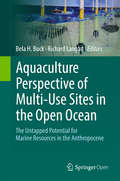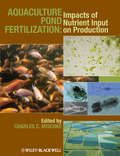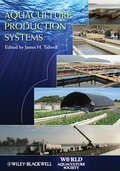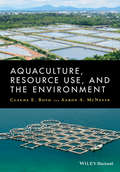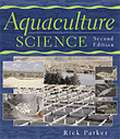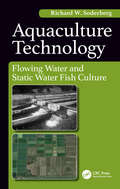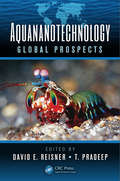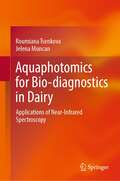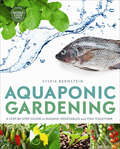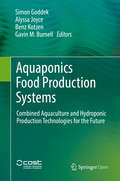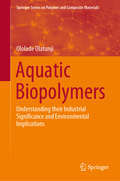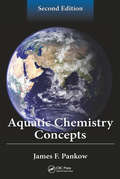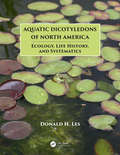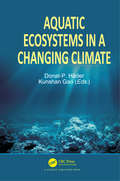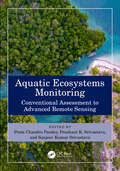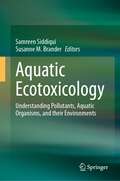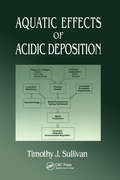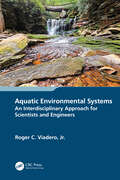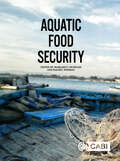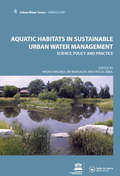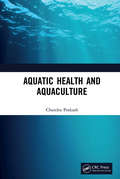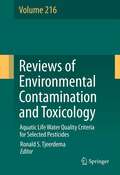- Table View
- List View
Aquaculture Perspective of Multi-Use Sites in the Open Ocean: The Untapped Potential for Marine Resources in the Anthropocene
by Bela H. Buck Richard LanganThis book is open access under a CC BY 4. 0 license. This volume addresses the potential for combining large-scale marine aquaculture of macroalgae, molluscs, crustaceans, and finfish, with offshore structures, primarily those associated with energy production, such as wind turbines and oil-drilling platforms. The volume offers a comprehensive overview and includes chapters on policy, science, engineering, and economic aspects to make this concept a reality. The compilation of chapters authored by internationally recognized researchers across the globe addresses the theoretical and practical aspects of multi-use, and presents case studies of research, development, and demonstration-scale installations in the US and EU.
Aquaculture Pond Fertilization: Impacts of Nutrient Input on Production
by Charles C. MischkePonds are a primary production system to a wide variety of freshwater fish species. Each species have specific and unique nutrient needs and successful pond fertilization is critical to a successful aquaculture enterprise. Aquaculture Pond Fertilization: Impacts of Nutrient Input on Production provides state-of-the-art information for successful fertilization strategies for a broad range of pond-raised species. Aquaculture Pond Fertilization attempts to rectify the seemingly contradictory nutrient recommendations by clearly defining the goals of specific types of aquaculture. Chapters are divided into three sections: The first reviews basic concepts in fertilization applicable to all pond-based production. The second looks at specific nutrient management approaches. The third and final section of chapters looks specifically at key freshwater pond species ranging from tilapia to perch and discusses specific fertilization needs for the successful rearing of these in-demand fish. Looking across species with chapters contributed by leaders in the field Aquaculture Pond Fertilization provides succinct single-volume coverage of an oft-neglected, but vitally important topic in aquaculture production.
Aquaculture Production Systems (World Aquaculture Society Book series)
by James H. TidwellAquaculture is an increasingly diverse industry with an ever-growing number of species cultured and production systems available to professionals. A basic understanding of production systems is vital to the successful practice of aquaculture. Published with the World Aquaculture Society, Aquaculture Production Systems captures the huge diversity of production systems used in the production of shellfish and finfish in one concise volume that allows the reader to better understand how aquaculture depends upon and interacts with its environment. The systems examined range from low input methods to super-intensive systems. Divided into five sections that each focus on a distinct family of systems, Aquaculture Production Systems serves as an excellent text to those just being introduced to aquaculture as well as being a valuable reference to well-established professionals seeking information on production methods.
Aquaculture, Resource Use, and the Environment
by Aaron Mcnevin Claude BoydAquaculture, Resource Use, and the Environment places aquaculture within the larger context of global population growth, increased demand for sustainable, reliable sources of food, and the responsible use of natural resources. Aquaculture production has grown rapidly in recent decades as over-exploitation and environmental degradation have drastically reduced wild fish stocks. As fish production has increased, questions have persisted about the environmental sustainability of current aquaculture practices. Aquaculture, Resource Use, and the Environment is a timely synthesis and analysis of critical issues facing the continued growth and acceptance of aquaculture practices and products. Chapters look at the past, present, and future demands for food, tackle key issues ranging from land and water use to mitigation of negative environmental impacts of fish production, and critically review aquaculture production systems. Providing broad coverage of issues that are essential to the continued development of aquaculture production, Aquaculture, Resource Use, and the Environment will be vital resource for anyone involved in the field of aquaculture.
Aquaculture Science
by Rick ParkerThis comprehensive text introduces students to the aquaculture industry. It covers every aspect of aquaculture, including history, potential, descriptions, management, feeding, marketing, and diseases of aquatic animals and plants. Also addressed are the water requirements and chemistry necessary for successful aquaculture. The book offers detailed information on employment opportunities in the aquaculture industry. The science of aquaculture is stressed throughout to ensure that students understand the fundamental principles. The text includes numerous pedagogical features to ensure students' success.
Aquaculture Technology: Flowing Water and Static Water Fish Culture
by Richard Soderberg W.Key features: Takes a quantitative approach to the science of aquaculture Covers the complete landscape of the scientific basis of fish culture Promotes problem solving and critical thinking Includes sample problems at the end of most chapters Guides the reader through the technical considerations of intensive aquaculture, including fish growth rates, hydraulic characteristics of fish rearing units, oxygen consumption rates in relation to oxygen solubility and fish tolerance of hypoxia, and water reconditioning by reaeration and ammonia filtration. Discusses the environmental effects of aquaculture Includes a chapter on hatchery effluent control to meet receiving water discharge criteria Aquaculture Technology: Flowing Water and Static Water Fish Culture is the first book to provide the skills to raise fish in both a flowing water and a static water aquaculture system with a pragmatic and quantitative approach. Following in the tradition of the author’s highly praised book, Flowing Water Fish Culture, this work will stand out as one that makes the reader understand the theory of each type of aquaculture system; it will teach the user "how to think" rather than "what to think" about these systems. The book presents the scientific basis for the controlled husbandry of fish, whether it be in a stream of water or a standing water pool. Part 1, Flowing Water Fish Culture, is a major revision of the author’s initial book and includes greatly expanded coverage of rearing unit design criteria, fish growth and the use of liquid oxygen, hatchery effluent control, and recirculating systems. Part 2, Static Water Fish Culture, presents the scientific basis of fish culture in standing water systems including nutrient and dissolved gas dynamics, pond ecology, effects of fertilization and supplemental feeding, water quality management and representative static water aquacultures. Aquaculture Technology conveys the science in a manner appropriate for use by university students and teachers and others involved in fish production and aquaculture research and development worldwide. It will enable the reader to adapt to changing technologies, markets, and environmental regulations as they occur.
Aquananotechnology: Global Prospects
by David E. Reisner T. PradeepThe world's fresh water supplies are dwindling rapidly-even wastewater is now considered an asset. By 2025, most of the world's population will be facing serious water stresses and shortages. Aquananotechnology: Global Prospects breaks new ground with its informative and innovative introduction of the application of nanotechnology to the remediatio
Aquaphotomics for Bio-diagnostics in Dairy: Applications of Near-Infrared Spectroscopy
by Roumiana Tsenkova Jelena MuncanThis book is the result of more than 20 years of experience in working with near-infrared spectroscopy for raw milk analysis. The totality of this work presents extensive possibilities for milk spectral measurements that can be carried out in dairy. Moving beyond the standard milk components such as fat, protein, or lactose, this book presents near-infrared spectroscopy as a method that can also be used in disease diagnostics. The measurements and experimental results presented here are all based on the utilization of usually neglected near-infrared regions—regions with strong absorbance of water. The author has found the water – light interaction discussed to be an immensely rich source of information, not only on milk composition but also on the physiological status of the animals involved. A special section of the book is dedicated to exploration of potential interfering factors that may influence the analysis and contribute to the robustness of the models. The research described in this book served as a basis for the development of the novel discipline aquaphotomics and is of interest to anyone working in this field.
The Aquaponic Farmer: A Complete Guide to Building and Operating a Commercial Aquaponic System
by Adrian Southern Whelm King&“The essential guide for people serious about setting up a commercial, cold-water aquaponic system.&” —Dr. Daniel Baker, Department of Fisheries and Aquaculture, Vancouver Island University Profitable cold-water fish and vegetable production. Join the aquaponic farming revolution! Built around a proven 120&’ greenhouse system operable by one person, The Aquaponic Farmer is the game changer that distills vast experience and complete step-by-step guidance for starting and running a cold-water aquaponic farming business—raising fish and vegetables together commercially. Coverage includes: A primer on cold-water aquaponics Pros and cons of different systems Complete design and construction of a Deep Water Culture system Recommended and optional equipment and tools System management, standard operating procedures, and maintenance checklists Maximizing fish and veg production Strategies for successful sales and marketing of fish and plants. As the only comprehensive commercial cold-water resource, The Aquaponic Farmer is essential for farmers contemplating the aquaponics market, aquaponic gardeners looking to go commercial, and anyone focused on high quality food production. Aquaponic farming is the most promising innovation for a sustainable, profitable, localized food system. Until now, systems have largely focused on warm-water fish such as tilapia. A lack of reliable information for raising fish and vegetables in the cool climates of North America and Europe has been a major stumbling block. The Aquaponic Farmer is the toolkit you need. &“Provides almost a step by step cookbook on all pertinent aspects of aquaponics and is based upon the authors&’ experiences from their own successful farm.&” —Michael B. Timmons, PhD & PE, Professor Biological & Environmental Engineering, Cornell University
Aquaponic Gardening: A Step-by-Step Guide to Raising Vegetables and Fish Together (Mother Earth News Books for Wiser Living)
by Sylvia Bernstein&“I have always wanted to figure out how to do sustainable aquaculture in the context of my home garden. Finally I&’ve got the book to help me do it.&” —Paul Greenberg, New York Times–bestselling author, Four Fish: The Future of the Last Wild Food Aquaponics is a revolutionary system for growing plants by fertilizing them with the waste water from fish in a sustainable closed system. A combination of the best of aquaculture and hydroponics, aquaponic gardening is an amazingly productive way to grow organic vegetables, greens, herbs and fruits, while providing the added benefits of fresh fish as a safe, healthy source of protein. On a larger scale, it is a key solution to mitigating food insecurity, climate change, groundwater pollution and the impacts of overfishing on our oceans.Aquaponic Gardening is the definitive do-it-yourself home manual, focused on giving you all the tools you need to create your own aquaponic system and enjoy healthy, safe, fresh and delicious food all year round. Starting with an overview of the theory, benefits and potential of aquaponics, the book goes on to explain: System location considerations and hardware components The living elements—fish, plants, bacteria, and worms Putting it all together—starting and maintaining a healthy system. Aquaponics systems are completely organic. They are four to six times more productive and use 90 percent less water than conventional gardens. Other advantages include no weeds, fewer pests, and no watering, fertilizing, bending, digging, or heavy lifting—in fact, there really is no down side! Anyone interested in taking the next step towards self-sufficiency will be fascinated by this practical, accessible and well-illustrated guide. &“An excellent primer for anyone considering home-scale aquaculture.&” —Peter Bane, publisher, Permaculture Activist and author, The Permaculture Handbook
Aquaponics Food Production Systems: Combined Aquaculture and Hydroponic Production Technologies for the Future
by Simon Goddek Alyssa Joyce Benz Kotzen Gavin M. BurnellThis open access book, written by world experts in aquaponics and related technologies, provides the authoritative and comprehensive overview of the key aquaculture and hydroponic and other integrated systems, socio-economic and environmental aspects. Aquaponic systems, which combine aquaculture and vegetable food production offer alternative technology solutions for a world that is increasingly under stress through population growth, urbanisation, water shortages, land and soil degradation, environmental pollution, world hunger and climate change.
Aquatic Biopolymers: Understanding their Industrial Significance and Environmental Implications (Springer Series on Polymer and Composite Materials)
by Ololade OlatunjiThis book presents a comprehensive survey about the most recent developments in industrial applications, processing techniques and modifications of polymers from marine sources. It systematically introduces the reader to the biomaterials Chitin, Collagen, Alginates, Cellulose and Polyesters and links their interwoven industrial significance and environmental implications. The book elucidates the impact of industrial sourcing of the aquatic system for organic and inorganic matter on the environment and deepens the understanding of the industrial and economic significance of aquatic biopolymers. Further it addresses the question of how to balance the conservation of aquatic life and the industrial and economic interest in developing biodegradable alternatives for plastic. Thus the book will appeal to scientists in the field of chemistry, materials and polymer science as well as engineering.
Aquatic Chemistry Concepts, Second Edition
by James PankowAquatic Chemistry Concepts, Second Edition, is a fully revised and updated textbook that fills the need for a comprehensive treatment of aquatic chemistry and covers the many complicated equations and principles of aquatic chemistry. It presents the established science of equilibrium water chemistry using the uniquely recognizable, step-by-step Pankow format, which allows a broad and deep understanding of aquatic chemistry. The text is appropriate for a wide audience, including undergraduate and graduate students, industry professionals, consultants, and regulators. Every professional using water chemistry will want this text within close reach, and students and professionals alike will expect to find at least one copy on their library shelves. Key Features Extremely thorough, one-of-a-kind treatment of aquatic chemistry Discussions of how to carry out complex calculations regarding the chemistry of lakes, rivers, groundwater, and seawater Numerous example problems worked in complete detail Special foreword by Jerry L. Schnoor
Aquatic Dicotyledons of North America: Ecology, Life History, and Systematics
by Donald H. LesAquatic Dicotyledons of North America: Ecology, Life History, and Systematics brings together a wealth of information on the natural history, ecology, and systematics of North American aquatic plants. Most books on aquatic plants have a taxonomic focus and are intended primarily for identification. Instead, this book provides a comprehensive overview of the biology of major aquatic species by compiling information from numerous sources that lie scattered among the primary literature, herbarium databases, and other reference materials. Included dicotyledon species are those having an obligate (OBL) wetland status, a designation used in the USACE National Wetland Plant List. Recent phylogenetic analyses are incorporated and rationale is provided for interpreting this information with respect to species relationships. This diverse assemblage of information will be useful to a wide range of interests including academic researchers, wildlife managers, students, and virtually anyone interested in the natural history of aquatic and wetland plants. Although focusing specifically on North America, the cosmopolitan distribution of many aquatic plants should make this an attractive text to people working virtually anywhere outside of the region as well. This book is an essential resource for assisting with wetland delineation.
Aquatic Ecosystems in a Changing Climate
by Donat-P Häder Kunshan GaoGlobal climate change affects productivity and species composition of freshwater and marine aquatic ecosystems by raising temperatures, ocean acidification, excessive solar UV and visible radiation. Effects on bacterioplankton and viruses, phytoplankton and macroalgae have farreaching consequences for primary consumers such as zooplankton, invertebrates and vertebrates, as well as on human consumption of fish, crustaceans and mollusks. It has affected the habitation of the Arctic and Antarctic oceans the most so far. Increasing pollution from terrestrial runoff, industrial, municipal and household wastes as well as marine transportation and plastic debris also affect aquatic ecosystems.
Aquatic Ecosystems Monitoring: Conventional Assessment to Advanced Remote Sensing
by Prem Chandra Pandey, Prashant K. Srivastava, and Sanjeev Kumar SrivastavaThis book collates traditional and modern applications of remote sensing in aquatic ecosystem monitoring. It covers conventional assessment methods like sampling, surveying, macroinvertebrates, and chlorophyll estimation for aquatic ecosystem health assessment. Advanced remote sensing technology provides timely spectral information for quantitative and qualitative assessment of water quality, shoreline changes, coral bleaching, and vegetation monitoring. The book covers different types of aquatic ecosystems like wetlands, rivers, lakes, saline, and the brackish lake. It also: Reviews the latest applications of remote sensing in the monitoring and assessment of aquatic ecosystems Includes traditional methods like cartography, sampling, surveying, phytoplankton assessment, river interlinking, and chlorophyll estimation Discusses the application of multi-source data and machine learning in monitoring aquatic ecosystems Discusses aquatic ecosystem management, services, threats, and sustainability Explores challenges, opportunities, and prospects of future Earth observation applications for aquatic ecosystem monitoring The book discusses space-borne, airborne, and drone geospatial data. The parts broadly cover aquatic ecosystem monitoring, vegetation management, advanced modeling practices, and challenges. It is meant for scientists, professionals, and policymakers working in environmental sciences, remote sensing, and geology.
Aquatic Ecotoxicology: Understanding Pollutants, Aquatic Organisms, and their Environments
by Samreen Siddiqui Susanne M. BranderThis textbook offers a basic understanding of aquatic ecotoxicology from molecular to physiological levels for graduate and advanced undergraduate students. The book covers the guidelines and lab protocols used by international organizations for ecotoxicology studies, and discusses the challenges faced by aquatic organisms in a changing climate from an ecotoxicological perspective. Readers will learn about pollutants, contaminants and chemicals of emerging concern (CECs) in aquatic environments, their impacts on environmental and human health, and what techniques can be used to curb and control their adverse impacts. The book will be useful for students in aquatic ecotoxicology, environmental pollution and marine biochemistry.
Aquatic Effects of Acidic Deposition
by Timothy J SullivanThe completion of the initial phase of the U.S. National Acid Precipitation Assessment Program (NAPAP) in 1990 marked the end of the largest environmental research and assessment effort to that time. The resulting series of 27 State of Science and Technology (SOS/T) Reports and the NAPAP Integrated Assessment represent a decade of work by hundreds
Aquatic Environmental Systems – an Interdisciplinary Approach for Scientists and Engineers
by Roger C. Viadero, Jr.Considering that environmental science draws students and practitioners with widely varied backgrounds, there is a need for materials that help readers to grow their knowledge of fundamental principles from chemistry, physics, and biology to understand, describe, and predict the ways in which constituents (sediment, nutrients, organic matter, etc.) interact and move in aquatic systems (rivers, lakes, groundwater, and the atmosphere). Aquatic Environmental Systems: An Interdisciplinary Approach for Scientists and Engineers focuses on developing a common vocabulary and a rigorous material balance-based approach to understanding these movements and interactions. It examines the key properties of water and the ways they impact the behavior of water in the environment, providing a focused enumeration of those aspects of water structure that have direct and profound impacts on aquatic environmental systems. Features: Provides open-ended exercises to allow students to tailor work to their personal local/regional interests. Focuses on conveying understanding of the underlying principles and assumptions/limitations which are frequently underemphasized or overlooked entirely in other books. Deemphasizes straight memorization while focusing on methods that can be applied to more broad-based problem solving. Accommodates a wide range of mathematics skills and backgrounds.
Aquatic Food Quality and Safety Assesment Methods
by R. Jeya Shakila G. JeyasekaranThe book explains on the methods and procedures adopted for testing the quality and safety of aquatic food products. The analytical techniques available for testing the chemical constituents of aquatic food with separate chapters on the analysis of lipids, proteins, vitamins, and minerals are exhaustively given to determine their nutritional quality. The various methods for sensory, physical, biochemical and microbiological quality assessments of aquatic food are explicitly given with detailed protocols for easy adoption. Special chapters covering the chemical contaminants and permitted additives for residue monitoring are dealt, as they are important food safety requirements. This book will be very helpful for the food quality control technologists, food analysts, research scholars, and fisheries professionals as a holistic guide on a variety of testing procedures for facile adoption to meet the food safety and quality regulatory requirements. Note: T& F does not sell or distribute the Hardback in India, Pakistan, Nepal, Bhutan, Bangladesh and Sri Lanka.
Aquatic Food Security
by Margaret Crumlish Rachel NormanAquatic Food Security explores a range of issues related to this subject using global examples to illustrate both the strengths and weaknesses within the existing aquatic food supply chain. This is already an area of vital importance, and it will increase in importance as the aquaculture industry grows for the foreseeable future. The book addresses: - the role of intensification in global aquaculture production; - the importance of nutrition and selective breeding; - diseases and public health considerations; - the role of markets and of processing; - retail sectors; and - quality issues in our global seafood.
Aquatic Habitats in Sustainable Urban Water Management: Urban Water Series - UNESCO-IHP
by Iwona Wagner; Jiri Marsalek; Pascal BreilAquatic habitats supply a wide range of vital ecosystem benefits to cities and their inhabitants. The unsustainable use of aquatic habitats, including inadequate urban water management itself, however, tends to alter and reduce their biodiversity and therewith diminish their ability to provide clean water, protect us from waterborne diseases and po
Aquatic Health and Aquaculture
by Chandra PrakashThis book discusses how to use the wastewaters, liquid biowastes and soils unfit for agriculture to economically viable aquaculture practices; and putting the emphasis on, aquaculture posology, the science of quantification and administration of doses in aquatic health and aquaculture management. Broadly, aquaculture practices come across three types of problems each; in the context of water quality, and fin fish and shell fish diseases; and preventive, curative and noncurative diseases in fin fish and shell fish. Note: T&F does not sell or distribute the Hardback in India, Pakistan, Nepal, Bhutan, Bangladesh and Sri Lanka.
Aquatic Life Water Quality Criteria for Selected Pesticides (Reviews of Environmental Contamination and Toxicology #216)
by Ronald S. TjeerdemaReviews of Environmental Contamination and Toxicology attempts to provide concise, critical reviews of timely advances, philosophy and significant areas of accomplished or needed endeavor in the total field of xenobiotics, in any segment of the environment, as well as toxicological implications.
Aquatic Macrophyte Risk Assessment for Pesticides
by Lorraine Maltby Dave Arnold Gertie Arts Jo Davies Fred Heimbach Christina Pickl Veronique PoulsenGiven the essential role that primary producers play in aquatic ecosystems, it is imperative that the potential risk of pesticides to the structure and functioning of aquatic plants is adequately assessed. An integration of regulatory and research information from key specialists in the area of environmental regulation, Aquatic Macrophyte Risk Asse
